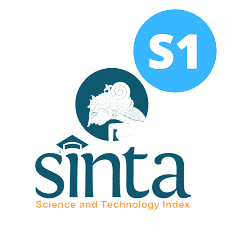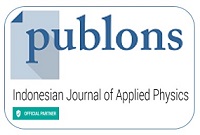Estimate The Focal Mechanism of Earthquake in Indonesia By Using 1-D Convolutional Neural Network (CNN)
Abstract
Indonesia is located between three collisions of active plate tectonics (Pacific, Eurasia, and Australia), resulting in a high seismicity zone, especially along the subduction zone. Besides the subduction zone, there are also many faults as a result of these collisions. As the earthquake source, both are controlled by focal mechanisms. Focal mechanism is the geometry of fault movements. Unfortunately, Indonesia's earthquake catalog data is not complete. There is missing information in some focal mechanism data, especially the data with more than 6 Magnitudes between January 1st, 1973, and February 1st, 2023. To complete the focal mechanism data, 1-D Convolutional Neural Network (CNN) is applied as the common and powerful method of Machine Learning. Started by grouping the earthquake catalog data with clear focal mechanism information as the training data with its training label and otherwise as the test data with the unknown label, then applied these training and label data to convolutional layer with some neurons, CNN can estimate focal mechanism (label) of the test data. This process is done iteratively, and a good model is observed with little loss value in the L curve.
Keywords
Full Text:
PDFReferences
1. Hutchings, S.J., Mooney, W.D.: The Seismicity of Indonesia and Tectonic Implications. Geochemistry, Geophys. Geosystems. 22, e2021GC009812 (2021). https://doi.org/https://doi.org/10.1029/2021GC009812
2. Sultan, R., Rachmat Sule, M., Hendriyana, A., Supendi, P.: Analysis of Focal Mechanism for Determine Fault Plane Orientation Using The Moment Tensor Inversion Case Study : West Java Geothermal Field. IOP Conf. Ser. Earth Environ. Sci. 318, 12036 (2019). https://doi.org/10.1088/1755-1315/318/1/012036
3. Handayani, T., Wijayanto, Saputro, A.H., Zulkifley, M.A., Djuhana, D.: Focal Mechanism and Moment Tensor Determination for Tsunami Early Warning Systems: A Literature Study (2018–2024). IEEE Access. 13, 140933–140972 (2025). https://doi.org/10.1109/ACCESS.2025.3594776
4. Zhang, C., Zhang, J., Zhang, J.: Deriving focal mechanism solutions of small to moderate earthquakes in Sichuan, China via a deep learning method. Earthq. Res. Adv. 5, 100371 (2025). https://doi.org/https://doi.org/10.1016/j.eqrea.2025.100371
5. Cheng, Y., Allen, R.M., Taira, T.: A New Focal Mechanism Calculation Algorithm (REFOC) Using Inter-Event Relative Radiation Patterns: Application to the Earthquakes in the Parkfield Area. J. Geophys. Res. Solid Earth. 128, e2022JB025006 (2023). https://doi.org/https://doi.org/10.1029/2022JB025006
6. Gok, R.: Earthquake Focal Mechanism and Waveform Modelling. , USA (2008)
7. Earthscope Consortium: Wilber 3: Select Event, https://ds.iris.edu/wilber3/find_event
8. Uchide, T.: Focal mechanisms of small earthquakes beneath the Japanese islands based on first-motion polarities picked using deep learning. Geophys. J. Int. 223, 1658–1671 (2020). https://doi.org/10.1093/gji/ggaa401
9. Funabiki, Y., Miyazawa, M.: Estimating Focal Mechanism of Small Earthquakes Using S/P Amplitude Ratios of Distributed Acoustic Sensing Records. Geophys. Res. Lett. 52, e2024GL113963 (2025). https://doi.org/https://doi.org/10.1029/2024GL113963
10. Mohammadi, A., Chen, X., Nakata, N., Dadi, S.: Focal Mechanism and Stress Analysis of the CAPE Site, Utah. (2025). https://doi.org/10.22541/essoar.176054449.92189091/v1
11. Mousavi, S.M., Beroza, G.C.: Machine Learning in Earthquake Seismology. Annu. Rev. Earth Planet. Sci. 51, 105–129 (2023). https://doi.org/https://doi.org/10.1146/annurev-earth-071822-100323
12. Kubo, H., Naoi, M., Kano, M.: Recent advances in earthquake seismology using machine learning. Earth, Planets Sp. 76, 36 (2024). https://doi.org/10.1186/s40623-024-01982-0
13. Takahashi, H., Tateiwa, K., Yano, K., Kano, M.: A convolutional neural network-based classification of local earthquakes and tectonic tremors in Sanriku-oki, Japan, using S-net data. Earth, Planets Sp. 73, 186 (2021). https://doi.org/10.1186/s40623-021-01524-y
14. Liu, X., Ren, T., Chen, H., Chen, Y.: Classification of tectonic and non-tectonic seismicity based on convolutional neural network. Geophys. J. Int. 224, 191–198 (2021). https://doi.org/10.1093/gji/ggaa444
15. Cheng, Y., Hauksson, E., Ben-Zion, Y.: Refined Earthquake Focal Mechanism Catalog for Southern California Derived With Deep Learning Algorithms. J. Geophys. Res. Solid Earth. 128, e2022JB025975 (2023). https://doi.org/https://doi.org/10.1029/2022JB025975
16. Perol, T., Gharbi, M., Denolle, M.: Convolutional neural network for earthquake detection and location. Sci. Adv. 4, e1700578 (2023). https://doi.org/10.1126/sciadv.1700578
17. Kuang, W., Yuan, C., Zhang, J.: Real-time determination of earthquake focal mechanism via deep learning. Nat. Commun. 12, 1432 (2021). https://doi.org/10.1038/s41467-021-21670-x
18. Bilal, M.A., Ji, Y., Wang, Y., Akhter, M.P., Yaqub, M.: An Early Warning System for Earthquake Prediction from Seismic Data Using Batch Normalized Graph Convolutional Neural Network with Attention Mechanism (BNGCNNATT), (2022)
19. Zhang, H., Melgar, D., Sahakian, V., Searcy, J., Lin, J.-T.: Learning source, path and site effects: CNN-based on-site intensity prediction for earthquake early warning. Geophys. J. Int. 231, 2186–2204 (2022). https://doi.org/10.1093/gji/ggac325
20. Wu, J.: Introduction to Convolutional Neural Networks. Presented at the (2017)
21. Alzubaidi, L., Zhang, J., Humaidi, A.J., Al-Dujaili, A., Duan, Y., Al-Shamma, O., Santamaría, J., Fadhel, M.A., Al-Amidie, M., Farhan, L.: Review of deep learning: concepts, CNN architectures, challenges, applications, future directions. J. Big Data. 8, (2021). https://doi.org/10.1186/s40537-021-00444-8
Refbacks
- There are currently no refbacks.
















